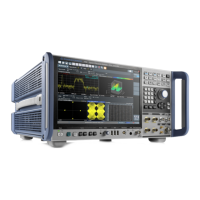Measurements and Results
R&S
®
FSW
137User Manual 1173.9411.02 ─ 43
7.1.3.2 Measuring the Signal Frequency Using the Signal Counter
The built-in signal counter allows you to measure the frequency more accurately than
measuring it with the marker. The frequency sweep is stopped at the marker, and the
R&S FSW measures the frequency of the signal at the marker position (see also Chap-
ter 9.3.4.1, "Precise Frequency (Signal Count) Marker", on page 532).
In the following example, the frequency of the generator at 128 MHz is shown using
the marker.
Prerequisite
Precise frequency measurements require a precise reference frequency. Therefore, an
external reference frequency from the signal generator is used. Connect the signal
generator's "Ref OUT" connector to the analyzer's "Ref IN" connector.
1. Select [PRESET] to reset the instrument.
2. Set the center frequency to 128
MHz.
3. Set the frequency span to 1
MHz.
4. Select "Setup" > "Reference" > "External Reference 10 MHz" to activate the exter-
nal reference frequency.
5. Select [MKR] to activate marker 1 and automatically set it to the maximum of the
trace.
The level and the frequency of the marker are displayed in the marker results in the
diagram or the marker table.
6. Select [MKR FUNC] > "Signal Count" to activate the signal counter.
The result of the signal counter is displayed in the marker results.
7. If necessary, increase the resolution of the signal counter by selecting "Signal
Count Resolution" (in the "Signal Count" menu).
Prerequisites for using the internal signal counter
In order to obtain a correct result when measuring the frequency with the internal sig-
nal counter, an RF sinusoidal signal or a spectral line must be available. The marker
must be located more than 25 dB above the noise level to ensure that the specified
measurement accuracy is adhered to.
7.1.4 Measurement Example – Measuring Levels at Low S/N Ratios
The minimum signal level a signal analyzer can measure is limited by its intrinsic noise.
Small signals can be swamped by noise and therefore cannot be measured. For sig-
nals that are just above the intrinsic noise, the accuracy of the level measurement is
influenced by the intrinsic noise of the R&S FSW.
Basic Measurements

